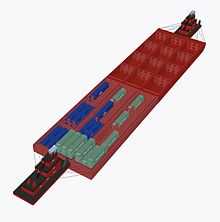Container on barge


Container on barge is a form of Intermodal freight transport where containers are stacked on a barge and towed to a destination on the Inland waterway.
Mississippi River & tributaries COB



There is limited use of this mode of transport because a lack of infrastructure on the upriver side in the United States. With the development of the Louisiana International Gulf Transfer Terminal at the mouth of the Mississippi River, container on barge traffic could become mainstream.
Lower Mississippi
The Lower Mississippi from St. Louis to the Port of New Orleans has no locks or dams and allows barges up to 7x6 or 42 barge units per tow. Oceangoing ships with drafts of about 40 feet (depending on the water level) and height clearances over 150 feet can navigate the waters up to Baton Rouge.
RoRo ship car carriers could traverse these waters up to Baton Rouge if there was a RoRo ship port to dock at.
Missouri River
The Missouri River has no lock and dams on it and from Omaha, Nebraska to St. Louis and there is only one lock and dam above St. Louis to lock through, the Chain of Rocks Lock, to get to the lower Mississippi.
Ohio River
The Ohio River has twenty, 1200 foot locks all the way up to Pittsburgh and locking through 1200 foot locks only takes about 30 minutes with a full 3x5, 15 unit barge.
Upper Mississippi
The upper Mississippi has 25+ locks and dams from St. Louis to Minneapolis that are 600-foot locks and only allow 6 to 8 barge units per tow without having to double lock through gates (double locking takes 2 hours+).
Barge carrying-capacity
Each barge unit can carry containers 3 wide by 4 long by 4 high for a total of 48+ FEU (forty-foot equivalent unit).
For an 8-unit barge on the upper Mississippi, that is a total of 384 FEU per tow.
On the Ohio and Missouri Rivers, the 15-unit barge could carry 720 FEU.
And on the lower Mississippi, where there are 42-unit barges, they could haul over 2000 FEUs. On the lower Mississippi, they could even be stacked five high because of higher bridge clearances.
Container transport in America
ISO containers come in 5 standard sizes 20's, 40's, 45's, 48's, and 53 footers. They can all stack on one another because all the connections and load bearing is at the 40 foot coupling, except for the 20's. They can't be stacked on top of longer containers; but placed side by side, 20's can be stacked on by longer containers.
Container ships
Container ships only take 20's, 40's, and 45's above deck. 90% of the containers on container ships are 40 footers.
Trains
Intermodal container trains in America come in two varieties, foreign and domestic.
- Domestic
Domestic intermodal trains carry 53 footers plus trailer-on-flatcars, and they travel throughout North America.
- Foreign
Foreign intermodal trains carry 20's, 40's, and 45's to and from container ports, to import or export on an intercontinental basis.
Container carriers
America's largest container carriers, JB Hunt, Schneider National, and Swift don't own a single 40-, 45-, or 20-foot container, making intercontinental shipping through them impossible. All the 40' shipping container companies are foreign, such as Maersk, MSC, or CMA CGM; or they are container leasing companies like Textainer or Triton.
None of these carriers has freight terminals to network-out American exports well. Intercontinental container shipping is full container load shipping, which contrasts with less than trailer load shipping.
See also
- Louisiana International Gulf Terminal
- Sacramento River Deep Water Ship Channel
- Port of Stockton
- Columbia River
- Hudson River
- Ohio River
- Missouri River
- TEU
- Rhine River
- Yangtze River
- Parana River
- Miracle on the Han River
- Danube River
- Long Combination Vehicle
- James River
References
http://towmasters.files.wordpress.com/2011/03/cob_port_concept_paper_seohiopa_2008.pdf